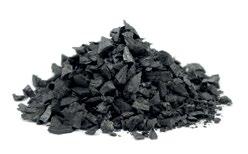
1 minute read
Molecule C60
MOLECULE C60 - Bucky ball
C60 belongs to the fullerene family (C60, C70, C76, C82 and C84 molecules). It is one of the eight allotropic forms of carbon in nature (the well- known forms are graphite and diamond).
Carbon, along with hydrogen, oxygen, nitrogen, phosphorus and sulfur is the basis of biological life and a building block of genes, proteins, lipids and other important biomolecules.
In a natural state it is so rare that it may be found in the most hidden places and only in trace amounts. It was found in a meteorite in Canada and it has been established that it was older than the solar system.
It is believed that it came from cosmic realms from red giant stars, where it was synthesized and ejected into space.
On earth, C60 can be found in trace amounts in a burning candle, as activated carbon, and in Russia in a mineral called shungite.




diamond face-centered cubic crystal fullerene diameter of C60: 700 pm
graphite hexagonal crystal layer distance: 335 pm
C60 is a molecule composed of 60 carbon atoms arranged in a geometric shape called a truncated icosahedron with the Fibonacci structure. It is the only molecule of a single element to form a spherical cage: C60 has 12 regular pentagonal and 20 regular hexagonal faces. No two pentagons share an edge, which could destabilize the structure.
The C60 colour is originally black in nature. The patented technology process of fullerene application changes it into the unique BIOPTRON® Quantum Hyperlight colour.










